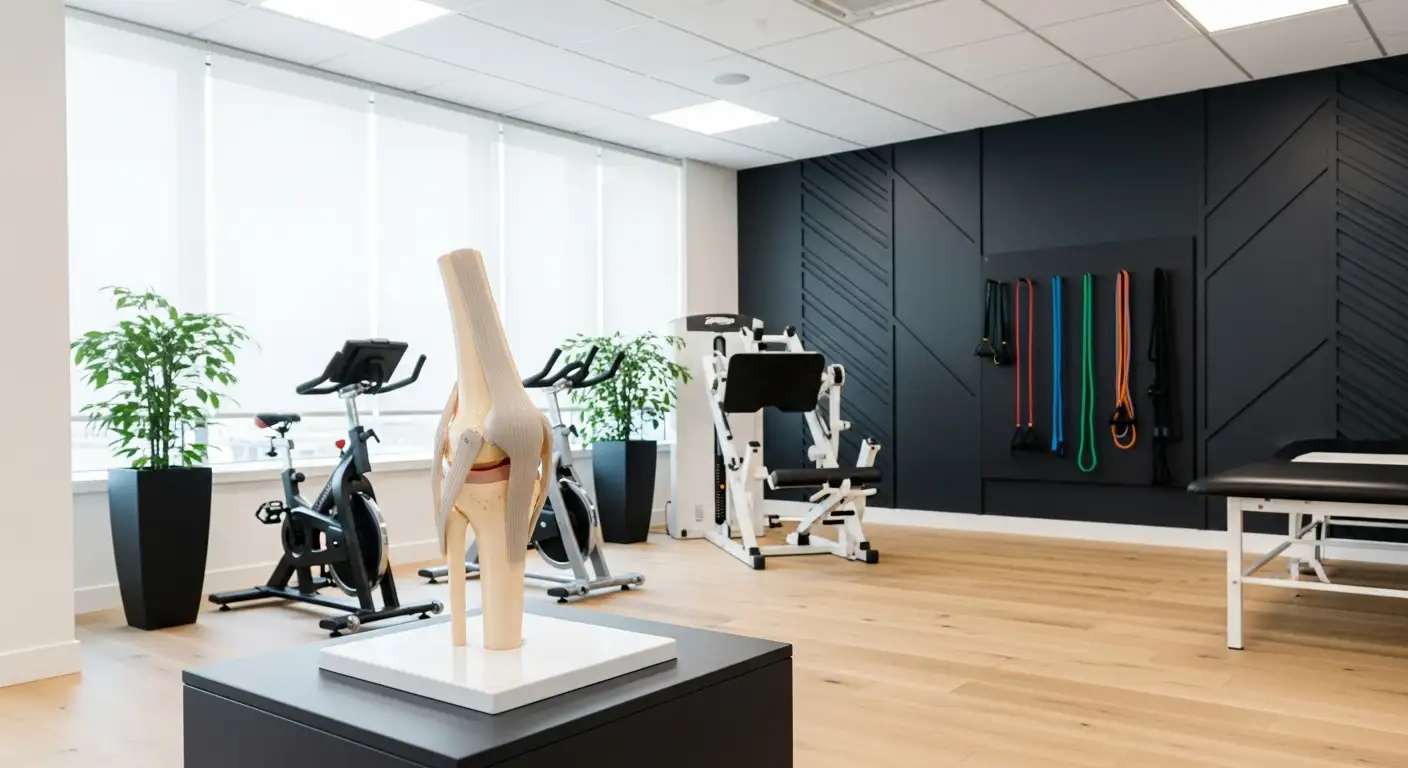Understanding Post-Surgery Swelling
Swelling after knee surgery is a natural part of the healing process. This section will cover the normal timeline for swelling and factors that can contribute to it.

Normal Timeline of Swelling
Postoperative swelling typically occurs immediately after knee surgery and is most pronounced during the first few days. The swelling can persist for an extended period, often lasting up to 6 months, but it usually decreases gradually over time.
TimeframeExpected Swelling LevelsDays 1-3Most noticeable; moderate to severe swellingWeeks 1-2Gradually decreases; moderate swellingMonths 1-3Mild to moderate swelling persistsMonths 4-6Continues to decrease; minimal swelling
This pattern reflects the body's response to surgery, where white blood cells and proteins rush to the surgical site to aid in the repair of tissues and combat potential infections [1].
Factors Contributing to Swelling
Various factors can influence the degree and duration of swelling after knee surgery. These may include:
Understanding these factors can aid in recognizing what is typical in the recovery process and inform patients when they might need to seek care regarding swelling, which raises the question, when should I worry about swelling after knee surgery?. Being aware of normal swelling patterns and contributing factors can help individuals navigate their postoperative recovery effectively.
Identifying Serious Symptoms
Post-surgery swelling can be a common occurrence following knee surgery. However, it is crucial to know when to worry about swelling and recognize signs that may indicate serious complications such as infections or blood clots.

Signs of Infection After Knee Surgery
Infections can occur during or after knee surgery and may pose severe risks if left untreated. It is essential to be vigilant for the following symptoms:
SymptomDescriptionRednessNoticeable red areas around the surgical site.PainIncreased or severe pain in the knee joint that does not improve.FeverA fever may indicate the body is fighting an infection.DischargePus or fluid leaking from the surgical site.
If any of these symptoms are observed, especially in the presence of swelling, it is advisable to consult a healthcare provider immediately. Infections may require antibiotic treatment, blood tests, or imaging studies for proper evaluation [4].
Recognizing Blood Clots
Swelling after knee surgery also raises concerns about deep vein thrombosis (DVT), which is the formation of blood clots in the veins. DVT can be life-threatening, particularly if a blood clot dislodges and travels to the lungs. Symptoms that may suggest the presence of a blood clot include:
SymptomDescriptionSwellingNew or severe swelling in the leg, especially after surgery.PainPain in the calf or thigh that may feel like cramping.WarmthThe affected area may feel warmer than the surrounding skin.Red or discolored skinThe skin over the affected area may show changes in color.
Immediate medical attention is necessary if these symptoms occur. Ignoring these signs can lead to severe complications. Monitoring changes in swelling and addressing these serious symptoms promptly is crucial for ensuring a safe recovery process. For more insights on related issues, you may find useful information on knee twitching and other knee conditions.
Managing Postoperative Swelling
Effective management of swelling after knee surgery is essential for promoting recovery and comfort. Two primary methods for dealing with postoperative swelling are ice therapy and compression stockings.
Ice Therapy for Swelling Reduction
Applying ice to the knee can significantly help reduce swelling following surgery. It is recommended to use an ice pack or cold compress 3 to 4 times a day for about 20 minutes each time. This helps restrict blood vessels, thereby minimizing the amount of blood and fluids reaching the surgical area.
Ice Application ScheduleDuration per SessionFrequency per DayIce Pack20 minutes3 - 4 times
If there is no observed improvement, it may be beneficial to consult a physical therapist or doctor for further recommendations [5]. Alongside icing, combining methods such as elevating the leg above heart level and performing ankle pumps can further assist in reducing swelling.
Utilizing Compression Stockings
Compression stockings are another effective tool for managing swelling and minimizing the risk of complications such as blood clots post-surgery. Doctors typically recommend wearing compression stockings for at least 2 weeks following surgery to help alleviate pain and swelling. These stockings provide extra support to the leg, promoting better circulation and reducing the feeling of aching in the legs [5].
Compression Stocking UseDurationMinimum Recommended Wear2 weeks
For the most effective recovery, combining ice therapy with compression stockings can optimize results. For those who may need additional support, exploring options like a knee stabilizer or an acl knee brace can further enhance recovery efforts. Understanding these management strategies is vital, especially when considering when should I worry about swelling after knee surgery?.
Addressing Persistent Swelling
Post-surgery swelling is a common experience for individuals recovering from knee surgery. However, if swelling persists beyond expected timelines and is accompanied by other symptoms, it could warrant further evaluation. Knowing when to seek medical attention and being vigilant about wound healing can be crucial aspects of recovery.
Seeking Medical Attention
Patients should monitor their symptoms closely after knee surgery. If the swelling becomes excessively severe or does not begin to subside within a few weeks, it is essential to consult a healthcare provider. Excessive swelling could be indicative of serious issues, such as a blood clot, which can pose significant health risks [4].
Some signs that may prompt a visit to a healthcare professional include:
SymptomsAction RequiredSevere swellingConsult a healthcare provider immediatelyPersistent or worsening painContact a doctorRedness or warmth around the kneeSeek medical evaluationFever or chillsInform healthcare provider
Monitoring these symptoms can help ensure timely intervention if complications arise.

Monitoring Wound Healing
Wound healing is an integral part of recovery after knee surgery. It's important to keep an eye on the surgical site for any unusual changes. In a study, wound complications were noted in about 7% of cases following total knee replacement surgeries [4]. Individuals should watch for signs of infection or poor healing, such as:
Wound ChangesWhat to Look ForRednessIncreased redness around the incisionSwellingSwelling that worsens instead of improvingDischargeAny unusual discharge or pusBleedingContinued bleeding that doesn’t stop
If any of these symptoms are present, it is crucial to inform a healthcare provider to assess the situation and possibly adjust the treatment plan. Being proactive can prevent potential complications and aid in a smoother recovery process.
Pain Management Strategies
Managing pain effectively after knee surgery is crucial for a smooth recovery. Strategies may involve medications for pain relief and approaches to handle bruising.
Medications for Pain Relief
Postoperative pain can vary, but it is often manageable with appropriate medications. Patients can utilize both prescription and over-the-counter (OTC) options. Prescription-strength nonsteroidal anti-inflammatory drugs (NSAIDs) such as ibuprofen or naproxen are common recommendations. For those experiencing more severe pain, stronger pain relievers like tramadol or oxycodone may be prescribed. OTC medications, including acetaminophen (Tylenol) and NSAIDs, can alleviate temporary pain and inflammation throughout the healing process.
Here's a breakdown of common medications used for pain management after knee surgery:
Medication TypeExamplePurposeOTC NSAIDsIbuprofen, NaproxenReduce pain and inflammationPrescription NSAIDsPrescription-strength IbuprofenManage severe painStronger Pain RelieversTramadol, OxycodoneAlleviate intense painAcetaminophenTylenolTemporary pain relief
Managing Bruising Post-Surgery
Bruising around the knee is a common side effect after surgery, with tenderness accompanying it. Typically, bruising lasts about 1 to 2 weeks, gradually subsiding during the recovery process. Effective management includes elevating the leg, which can help reduce inflammation and bruising.
In addition to elevation, wearing compression stockings may also aid in minimizing swelling and discomfort. Doctors often recommend using them for at least two weeks following surgery to enhance recovery.
In dealing with recovery, patients should monitor their symptoms closely to determine when should i worry about swelling after knee surgery?. If any unusual symptoms arise, consulting a healthcare provider is advisable to ensure proper healing.
Physical Therapy for Recovery
Physical therapy is a key component in the recovery process after knee surgery. Engaging in a structured physical therapy program can significantly enhance healing, improve mobility, and reduce pain.
Role of Physical Therapy
Physical therapists develop customized plans aimed at strengthening the knee and surrounding muscles, increasing range of motion, and promoting overall recovery. They play a vital role in ensuring that patients adhere to safe exercises while avoiding movements that could lead to complications, such as squatting, jumping, or kneeling. This guidance is essential as it helps prevent further injury and supports efficient healing [5].
Patients typically work with therapists to learn proper techniques, which may include:
By implementing these strategies, individuals recovering from knee surgery can significantly improve their outcomes.
Recommended Exercises
Following a knee surgery, certain exercises are commonly recommended to facilitate recovery. Below is a table outlining some typical exercises and their intended benefits:
ExercisePurposeAnkle PumpsPromotes blood circulation and reduces swelling.Straight Leg RaisesStrengthens quadriceps muscles without stressing the knee.Heel SlidesEnhances knee mobility and flexibility.Quad SetsStrengthens the quadriceps while keeping the leg straight.Step-UpsImproves strength and stability (ensure to perform cautiously).
Performing these activities as prescribed can aid in a more effective recovery process. It is essential for individuals to consult their physical therapist for specific exercises tailored to their unique needs, particularly in relation to swelling and pain.
Monitoring progress with these exercises can help address any concerns related to swelling and mobility, enabling individuals to ask, "when should I worry about swelling after knee surgery?" as they continue their recovery journey.
References
[2]:
[3]:
[4]:
[5]:
[6]:




